SubREAL During the 1990s: Ironic Monuments, Tainted Blood, and Vampiric Realism in a Time of Transition
During the 1990s the subREAL group(subREAL was founded in April 1990 by Calin Dan and Dan Mih?l?ianu. Iosif Király joined the group in February 1991. In August 1993 Dan Mih?l?ianu left subREAL, which operates since as an artist-duo.) – the first of its kind from Romania to operate in an international context after 1989 – investigated the culture of late-communist Romania and the subsequent period of (post-1989) transition, with its turn to a more or less unbridled form of liberal capitalism and the establishment of democratic institutions that continued to be dominated by the old elites. In their work with photography, film, installation, and performance subREAL explored the travesties and myths of the period of transition and its ramifications for artists working in Romania at the time. Among the themes the group addressed were the traditional clichés and myths about Romania whose prominence seemed to only grow (atavistically) after 1989; the canonical legacy of high modernism; the increasing marketability of art from Eastern Europe, including Romania, on the global art market; the fetishization of the (vanished) “Other” of Communism; and the problem of independent artistic expression in a post-1989 world dominated by intensified consumerism and special economic and political interests.
 Of particular relevance to the artists is the relationship between (artistic) production and consumption, including the consumption of art itself.(Given the increased emphasis on consumerism and consumption during the 1990s, this is not a coincidence.) For Marx, production and consumption were two sides of the same coin, human labor: whoever develops his or her faculties in production, uses (consumes) these faculties during further production, much like a plant consumes oxygen and water and develops new plants in the process.(Karl Marx, “Introduction to a Contribution to the Critique of Political Economy,” at http://www.marxists.org/archive/marx/works/1859/critique-pol-economy/appx1.htm. Accessed November 17, 2012.) subREAL take up this idea and reproduce it in their own way in the context of transitional Romania during the early 1990s. Thus in the installation Erzsebeth (Draculaland 4 [1993]) the artists include a bottle of their own blood, ironically suggesting that the ideal coupling of production and consumption that Marx espoused can still survive in art: the artists produce their own blood and then consume it as part of their artistic work. Video footage of the artists’ blood letting for the Erzsebeth installation was subsequently used in two other performances (Communication 1:1; Communication 1:1:1) that link the artists’ blood to the century-old arguments between Romania and Hungary over Draculaland (Transylvania). In these cases, the footage of the two artists letting blood into one and the same bottle—suggesting they are “brothers in blood”—hints both at the blood relations between Hungarians and Romanians (as if to say, “on both sides of the border, people produce their own blood and consume their own homemade brandy”[Additionally, Király is half Hungarian.]) and, in typical subREAL fashion, at another thing the Romanian and Hungarian communities had in common: the desire to leave their respective communities for a faraway land, America, that is arguably populated by white colonizers who seal their unlikely liaisons with select members of the colonized population by blood. Indeed, films inspired by the novels of the German “Wild West” novelist Karl May – centered on the Blutsbrüderschaft(The English translation of this term is “brothers in blood.”) between the white Old Shatterhand and his “Indian” friend Winnetou – were highly popular in Romania in the 1970s and early 1980s, and spawned a series of films in East Germany, Yugoslavia and Romania itself, where one spin off featured people from Transylvania who also lived in 19th century America.(http://www.utne.com/mind-body/Germans-weekends-Native-Americans-Indian-Culture.aspx?page=2. Accessed September 5, 2012.)
Of particular relevance to the artists is the relationship between (artistic) production and consumption, including the consumption of art itself.(Given the increased emphasis on consumerism and consumption during the 1990s, this is not a coincidence.) For Marx, production and consumption were two sides of the same coin, human labor: whoever develops his or her faculties in production, uses (consumes) these faculties during further production, much like a plant consumes oxygen and water and develops new plants in the process.(Karl Marx, “Introduction to a Contribution to the Critique of Political Economy,” at http://www.marxists.org/archive/marx/works/1859/critique-pol-economy/appx1.htm. Accessed November 17, 2012.) subREAL take up this idea and reproduce it in their own way in the context of transitional Romania during the early 1990s. Thus in the installation Erzsebeth (Draculaland 4 [1993]) the artists include a bottle of their own blood, ironically suggesting that the ideal coupling of production and consumption that Marx espoused can still survive in art: the artists produce their own blood and then consume it as part of their artistic work. Video footage of the artists’ blood letting for the Erzsebeth installation was subsequently used in two other performances (Communication 1:1; Communication 1:1:1) that link the artists’ blood to the century-old arguments between Romania and Hungary over Draculaland (Transylvania). In these cases, the footage of the two artists letting blood into one and the same bottle—suggesting they are “brothers in blood”—hints both at the blood relations between Hungarians and Romanians (as if to say, “on both sides of the border, people produce their own blood and consume their own homemade brandy”[Additionally, Király is half Hungarian.]) and, in typical subREAL fashion, at another thing the Romanian and Hungarian communities had in common: the desire to leave their respective communities for a faraway land, America, that is arguably populated by white colonizers who seal their unlikely liaisons with select members of the colonized population by blood. Indeed, films inspired by the novels of the German “Wild West” novelist Karl May – centered on the Blutsbrüderschaft(The English translation of this term is “brothers in blood.”) between the white Old Shatterhand and his “Indian” friend Winnetou – were highly popular in Romania in the 1970s and early 1980s, and spawned a series of films in East Germany, Yugoslavia and Romania itself, where one spin off featured people from Transylvania who also lived in 19th century America.(http://www.utne.com/mind-body/Germans-weekends-Native-Americans-Indian-Culture.aspx?page=2. Accessed September 5, 2012.)
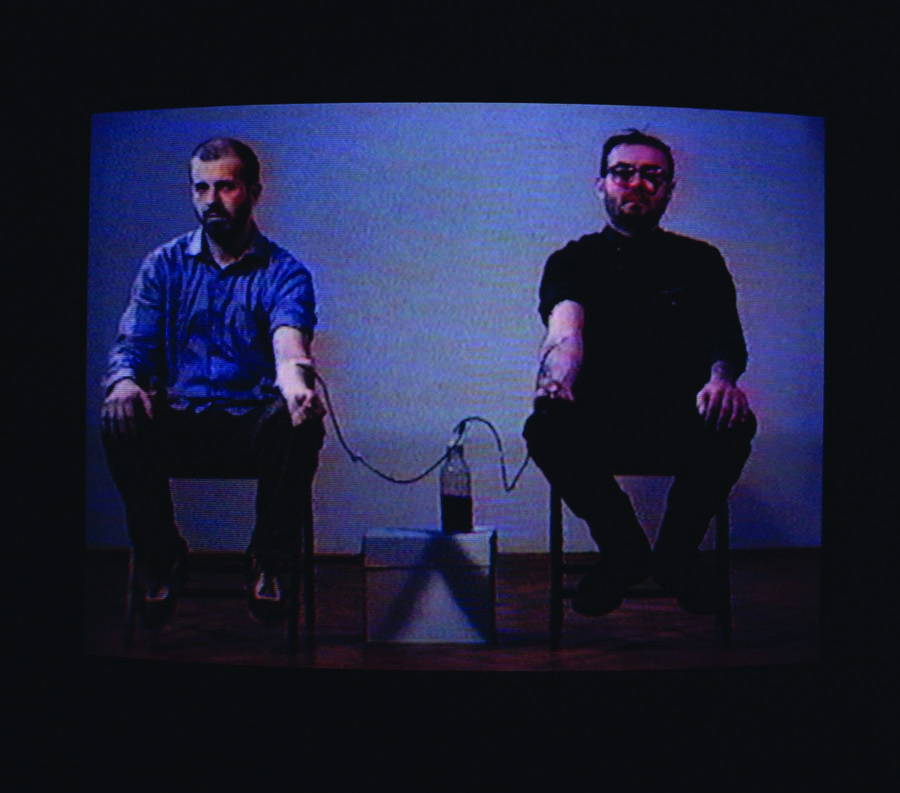
subREAL’s preferred medium during the 1990s were installations conceived as what I want to call “ironic monuments” (ironische Denkmäler): by this I mean monuments that undermine their own readability as commemorative acts through the inclusion of elements – allusions or other subtexts – that contest that act’s legitimacy or feasibility. For instance, while Communication 1:1 and Communication 1:1:1 may be read as thoughtful references to the many things Romanians and Hungarians have in common – for one thing, both produce their own blood –, there is also a more sinister, if unspoken, reference at work here: during the mid-1990s, German pharmaceutical companies, with the blessing of the Romanian authorities, bought HIV-contaminated blood from poor inhabitants of Romania’s capital and then sold it in the West. On the one hand, this historical allusion questions the more Romantic reference to the (blood) connections between Romanians and Hungarians implicit in Erzsebeth 4 by suggesting that the Blutsbrüderschaft between the two peoples might turn out deadly; on the other hand, the “bad blood” produced in the East can also be highly profitable (symbolically and/or financially), even if it’s deadly in the long run: it’s hardly a coincidence that subREAL establish their web of interlocking allusions within the medium of art, since the German pharmaceutical company that purchased the tainted blood from an impoverished part of the Romanian population might easily be compared to international art collectors and curators whose interest in the “tainted blood” of Communism, and in art produced by another part of less-than-privileged Eastern European society, namely artists, was steadily rising at the time subREAL produced their installations.
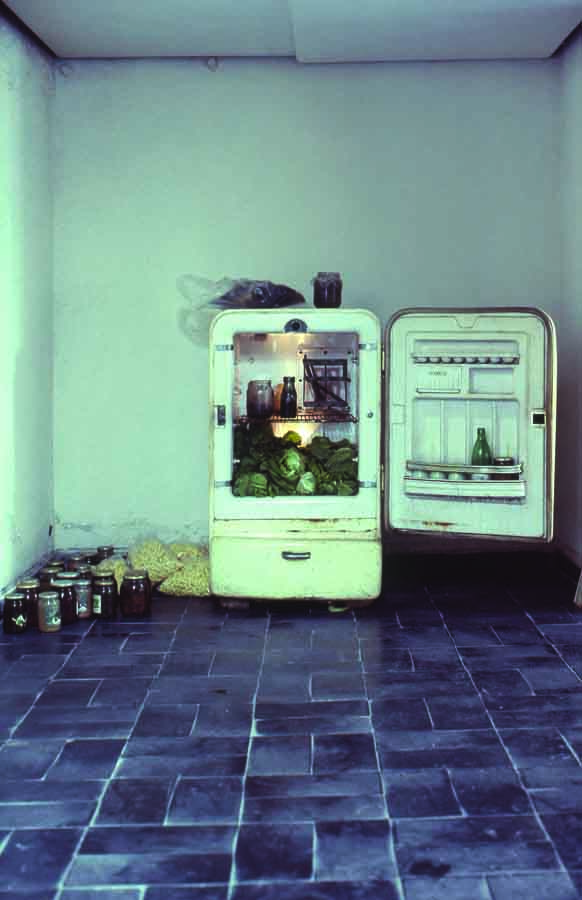 To give a couple of more examples of ironic monuments in subREAL’s work, the installation Sphinx (1994) – the title hinting that the late Ceaucescu era, inevitably functions as a kind of oracle, a skewed prism through which for better or for worse the present moment needs to be understood – consists of a ramshackle Romanian pantry from the 1980s made from wood. The installation is one of several where subREAL draw on their own biographies to reconstruct the material culture of the 1980s. During that time, many of the food items here under display were in short supply, which is why the shelves lining the pantry are filled with mostly empty jars. While we might see in this installation a nostalgic return (a monument) to the established, if precarious, certainties of the Ceaucescu era, subREAL undercuts this proposition by affixing labels to the jars that are reminiscent of newspaper obituaries. The group adds a further ironic twist by insisting that the dates on the labels do not inform viewers of the freshness of the product (the jars are empty) but rather of “the lifespan (birth and death) of the ideas that the members of subREAL had between their own birth […] and the founding of the group (August 1990).”(subREAL, Akten/Files, (exhib. cat. Neuer Berliner Kunstverein/Künstlerhaus Bethanien, Berlin), 1996, p. 72.) The monument devoted to material life under Communism turns out to be an ironic commentary on the difficulty of substituting ideas for food: by the early 1990s, all the ideas that once animated the artists had exceeded their lifespan and could only be consumed as dead matter (and as such they enter subREAL’s installations).
To give a couple of more examples of ironic monuments in subREAL’s work, the installation Sphinx (1994) – the title hinting that the late Ceaucescu era, inevitably functions as a kind of oracle, a skewed prism through which for better or for worse the present moment needs to be understood – consists of a ramshackle Romanian pantry from the 1980s made from wood. The installation is one of several where subREAL draw on their own biographies to reconstruct the material culture of the 1980s. During that time, many of the food items here under display were in short supply, which is why the shelves lining the pantry are filled with mostly empty jars. While we might see in this installation a nostalgic return (a monument) to the established, if precarious, certainties of the Ceaucescu era, subREAL undercuts this proposition by affixing labels to the jars that are reminiscent of newspaper obituaries. The group adds a further ironic twist by insisting that the dates on the labels do not inform viewers of the freshness of the product (the jars are empty) but rather of “the lifespan (birth and death) of the ideas that the members of subREAL had between their own birth […] and the founding of the group (August 1990).”(subREAL, Akten/Files, (exhib. cat. Neuer Berliner Kunstverein/Künstlerhaus Bethanien, Berlin), 1996, p. 72.) The monument devoted to material life under Communism turns out to be an ironic commentary on the difficulty of substituting ideas for food: by the early 1990s, all the ideas that once animated the artists had exceeded their lifespan and could only be consumed as dead matter (and as such they enter subREAL’s installations).
 In another installation, Alimentara (1991) – named after Romania’s only chain of supermarkets during Communism, Alimentara – the artists take upa similar idea. Here the ironic monument consists of a large pyramid of food jars containing (mostly) vegetables, the only consumer goods that were readily available at the stores during the 1980s. The installation, which takes its visual cue from food displays during the Communist era, further included a fridge; two hotplates; several bottles of wine; spare ribs; a half-rotten chicken (an equivalent to the rotten ideas in Sphinx), and other items whose purchase, according to the artists, required elaborate rituals (especially standing in line) and great patience. Once again, this installation commemorates the precarious consumer habits formed under the Ceaucescu regime (in fact the pyramid recalls a practice well-known from other countries of the former Eastern Bloc during times when consumer goods were in short supply: supermarkets would create “sculptures” of the same product in various parts of the store in order to hide the fact that there were no other products).
In another installation, Alimentara (1991) – named after Romania’s only chain of supermarkets during Communism, Alimentara – the artists take upa similar idea. Here the ironic monument consists of a large pyramid of food jars containing (mostly) vegetables, the only consumer goods that were readily available at the stores during the 1980s. The installation, which takes its visual cue from food displays during the Communist era, further included a fridge; two hotplates; several bottles of wine; spare ribs; a half-rotten chicken (an equivalent to the rotten ideas in Sphinx), and other items whose purchase, according to the artists, required elaborate rituals (especially standing in line) and great patience. Once again, this installation commemorates the precarious consumer habits formed under the Ceaucescu regime (in fact the pyramid recalls a practice well-known from other countries of the former Eastern Bloc during times when consumer goods were in short supply: supermarkets would create “sculptures” of the same product in various parts of the store in order to hide the fact that there were no other products).
In its focus on exchange and consumption Alimentara may be compared to another store in an iconic work of pop art, Claes Oldenburg’s Lower East Side Store (1961), containing sculpted consumer products all made of the same material. However, while Store worked on the assumption of a pervasive eroticization of consumption (with the artist as the potent sculptor-shopkeeper who “serves” his medium), subREAL’s counterpart, with its  replacement of the sculpted consumer fetish by the drabness of “the real thing” (real spoilt chicken; real food jars), hints not only at communist Romania’s poverty relative to the presumed abundance of the West, but also at subREAL’s rejection of the idea that art can be called upon to re-animate the dead matter of consumption. In subREAL’s store there is, literally, nothing to sell and hence to consume, least of all the spirit of the consumer object itself.
replacement of the sculpted consumer fetish by the drabness of “the real thing” (real spoilt chicken; real food jars), hints not only at communist Romania’s poverty relative to the presumed abundance of the West, but also at subREAL’s rejection of the idea that art can be called upon to re-animate the dead matter of consumption. In subREAL’s store there is, literally, nothing to sell and hence to consume, least of all the spirit of the consumer object itself.
The link between consumption and ideology – which here figures both as the ideology of consumption and as the consumption of ideology itself, is central to subREAL’s work. In their work the artists create a (highly eclectic) shopping list of cultural exports that Romania can bring to satisfy the culinary desires of the post-1989 global (art) market, from emigré Romanian modernists (Brancusi) to Dracula; Transylvania; Romanian folk dance; the dogs of Bucharest; HIV-infested blood; and of course the trappings of Communism. In a performance produced in Berlin in 1994 (Bodies in Motion), the artists play a tape with narrative reports about illegal emigration from Romania before and after 1989, against a background of pop music and slides of tourist destinations in Romania, Western Europe, and the USA. On the one hand, Bodies in Motion hints, somewhat predictably perhaps, that the widespread desire to leave the Eastern Bloc was based on an idealized misunderstanding of life behind the iron curtain (= “the ideology of consumption”). On the other hand, the migrants’ stories soon became themselves spectacular objects of consumption after the fall of the Berlin wall, when they were incorporated into the general narrative that represented the end of Communism as a victorious act of liberation at the hands of Western democracies (= “the consumption of ideology”). As subREAL comment: “After December 1989 […] the desired borders shifted towards the West and the media became interested in these stories, as it were as part of a liberated Romania’s integration into Europe.”(Ibid., p. 80.)
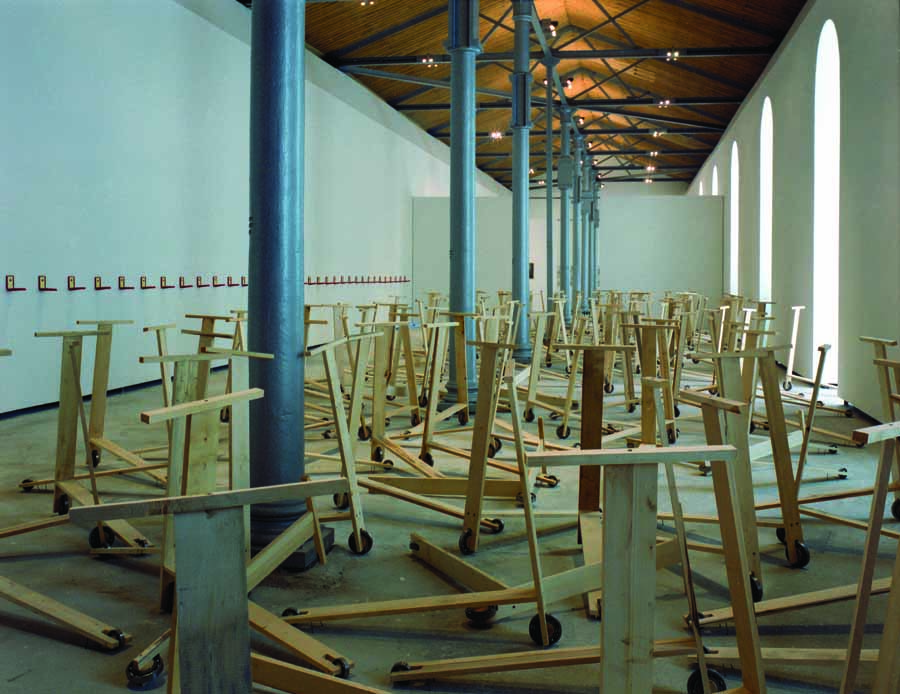 subREAL consistently questions the binary East/West opposition that characterized the cold war as much as its aftermath during the 1990s. While the East/West opposition as it established itself after 1989 affirmed and valorized the marginal and the peripheral to a degree, it left the binary structure itself intact, with the now valorized margin (Eastern Europe) reaffirming the importance of the affirming center (the West). In their installations subREAL replace this opposition with an alternative “East/East” pairing that aims to undermine the productivity of the post-cold war narrative. In an installation entitled Eurasia (presented at the 3rd Istanbul Biennial 1992) subREAL humorously hint at Romania’s place in the new world order by installing on the gallery wall a long row of genuine cases used in communist Romania for the order Meritul Cultural Clasa V (Medal 5th Category for Cultural Merits). Each of the cases contained a ball bearing from Romanian production (a tape in the background played the sounds of a ball bearing rolling down a concrete surface). Meanwhile three hundred wooden scooters with roller bearing wheels were scattered throughout the gallery. The accompanying catalogue text explains: “The Romanian ball bearing industry was the pride of the former communist regime. Since December 1989 the production is increasingly diverted into a broad network of smugglers organized via Istanbul.”(Ibid., p. 36.)
subREAL consistently questions the binary East/West opposition that characterized the cold war as much as its aftermath during the 1990s. While the East/West opposition as it established itself after 1989 affirmed and valorized the marginal and the peripheral to a degree, it left the binary structure itself intact, with the now valorized margin (Eastern Europe) reaffirming the importance of the affirming center (the West). In their installations subREAL replace this opposition with an alternative “East/East” pairing that aims to undermine the productivity of the post-cold war narrative. In an installation entitled Eurasia (presented at the 3rd Istanbul Biennial 1992) subREAL humorously hint at Romania’s place in the new world order by installing on the gallery wall a long row of genuine cases used in communist Romania for the order Meritul Cultural Clasa V (Medal 5th Category for Cultural Merits). Each of the cases contained a ball bearing from Romanian production (a tape in the background played the sounds of a ball bearing rolling down a concrete surface). Meanwhile three hundred wooden scooters with roller bearing wheels were scattered throughout the gallery. The accompanying catalogue text explains: “The Romanian ball bearing industry was the pride of the former communist regime. Since December 1989 the production is increasingly diverted into a broad network of smugglers organized via Istanbul.”(Ibid., p. 36.) 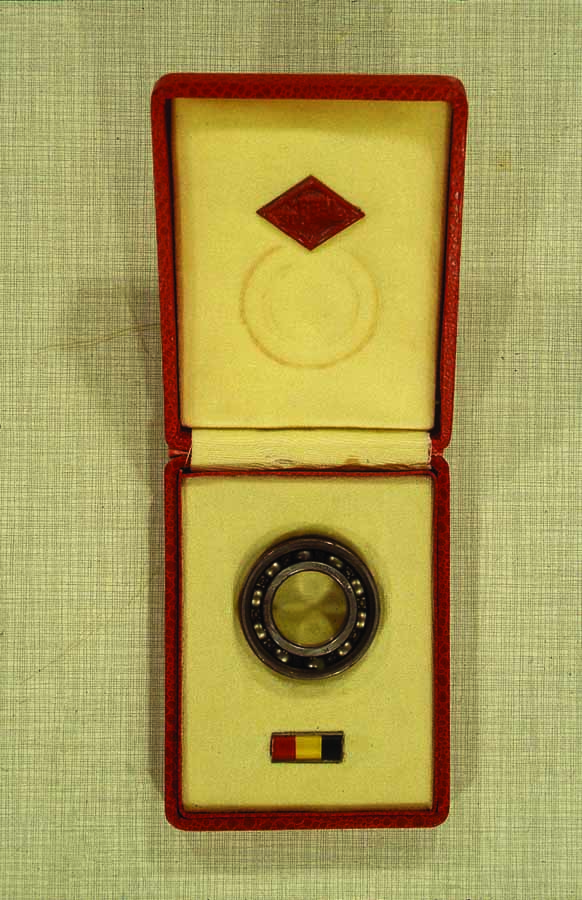 A recurrent trope in subREAL’s work, smuggling here fulfills a performative function: like the smugglers alluded to in the installation, subREAL bring Romanian ball bearings to Istanbul. Which means that they, too, are part of the network that diverts the jewels of Communist production to a place where it does not belong: the museum, where this contraband, much like the smuggled ball bearings themselves, becomes whitewashed by being declared art and awarded a prize. The Istanbul Biennial, here, becomes a metaphor for the international art market that trades in the material remains of the Communist experiment and commodifies them.
A recurrent trope in subREAL’s work, smuggling here fulfills a performative function: like the smugglers alluded to in the installation, subREAL bring Romanian ball bearings to Istanbul. Which means that they, too, are part of the network that diverts the jewels of Communist production to a place where it does not belong: the museum, where this contraband, much like the smuggled ball bearings themselves, becomes whitewashed by being declared art and awarded a prize. The Istanbul Biennial, here, becomes a metaphor for the international art market that trades in the material remains of the Communist experiment and commodifies them.
In a series of installations, subREAL refer to a territory they call Draculaland. The implied allusion to Disneyland is not coincidental since the historical connections between Bram Stoker’s novel and its supposed historical model, the 15th century Transylvanian ruler Vlad the Impaler, were popularized by a Romanian academic, Radu Florescu, who spent most of his life in the United States. Which is to say that Dracula must be understood as a collaborative effort between America and Romania, somewhere between academia and the film industry. Here again we are dealing with a playful subversion of the expected West/East trajectories: as a media effect, Dracula is the result of an elaborate operation between hemispheres that projects a novel by a Victorian novelist back on Romania via Hollywood.
In the work of subREAL, Dracula(land) functions not so much as a term with a fixed meaning than as what with Roland Barthes we might identify as a “reality effect.” In his important 1968 article of the same title, Barthes, using the example of Flaubert, describes the way in which realist literary fiction evokes the illusion of an objectified real freed from ideological constraints. Using terminology borrowed from structural linguistics, Barthes argues that this happens by the suppression of the signified: realist fiction achieves the effect of “objective” verisimilitude by including (not unlike photography, in this regard) a host of seemingly peripheral details that play no role in the overall structure of the narrative. These details have as their signified notthe actual meaning or function of the object included (a barometer that is listed as one of the objects in a room may be utterly irrelevant to the events that unfold in this same room), but rather the reality effect that is the result of their inclusion in the description. By this token the very fact that these details lack specific meaning or relevance inside the narrative becomes their signified. This technique, whose goal is the representation of reality as magically freed from the taint of ideology, is however in itself an intensely ideological operation, for it is designed to present as objective what is in reality the perspective of one very specific class of people, the bourgeoisie.
With respect to the Dracula story, we might say that it represents much more than simply an illustration of the Barthesian reality effect – Dracula is in fact that effect’s succinct enactment. Reality effects are vampiric by nature, for in Realist fiction words are literally “sucked dry” by being deprived of their signifieds in order to veil fiction’s ideological entanglements. This condition of utter alienation of objects/words from their own meaning – a token of their mode of (capitalist) production – is in fact the principal subject of subREAL’s work during the 1990s, and in this sense “Dracula” may be said to preside even over those of their installations where he does not make an explicit appearance. When in their work (Alimentara, etc.) subREAL include a host of consumer objects from Communist times, they produce an equivalent to the way in which Flaubert creates his fictional world out of objects that do not have a home in that world. Much as is the case in realist fiction, the cigarettes, pickled vegetables and other goods that appear in subREAL’s installations do not belong in the (art) environment in which they are now being presented; however, it is in their very alienation from their original context (Communism) that they offer a tantalizing reality effect of the new reality of capitalism and its alienated/alienating conditions of production and consumption. For as art objects, the elusive consumer goods from the Communist era are now being consumed by international art connaisseurs for whom these objects mean nothing at all beyond being authentic art “from the East.”
In their first public installation entitled East-West Avenue (1990), subREAL installed a series of metal plaques with handwritten inscriptions along the large avenue leading from Ceaucescu’s Casa Poporului (House of the People) to Unirii (Unity) Square. The “House of the People,” which is now home to Romania’s Parliament and to the National Museum of Contemporary Art, is one of the largest buildings in the world, and its close association with the megalomaniac Ceaucescu – whose nickname was not coincidentally, Vampirescu – links it to Dracula’s Transylvanian castle. The connection is reinforced on the metal plates themselves, which are inscribed with the trades of workers who contributed to the construction of the palace. These are reminiscent of the makeshift monuments erected by construction workers during the 1980s to commemorate fellow workers who were killed during the construction of the palace, and removed by the authorities: “The plates are reminiscent of small signs of worship that are installed in places where a human being died a violent death.”(subREAL, Akten/Files, (exhib .cat. Neuer Berliner Kunstverein/Künstlerhaus Bethanien, Berlin), 1996, p. 16.) In Bram Stoker’s novel, Jonathan Harker, a British solicitor, travels to Count Dracula’s crumbling Transylvanian castle in order to provide legal council to Dracula for a real estate transaction. With Dracula, it’s always about real estate, about securing the Count’s castle from threat and invasion – if necessary, by razing an entire part of town – and about concealing this reality below a veneer of ideology. And so subREAL read the original monuments erected by Ceaucescu’s workers to commemorate their killed colleagues as metaphorical pointers to the fact that it was Ceaucescu (“Vampirescu”), the master of the House (resembling the castle), who killed the workers by sucking out their blood in order to secure his home.
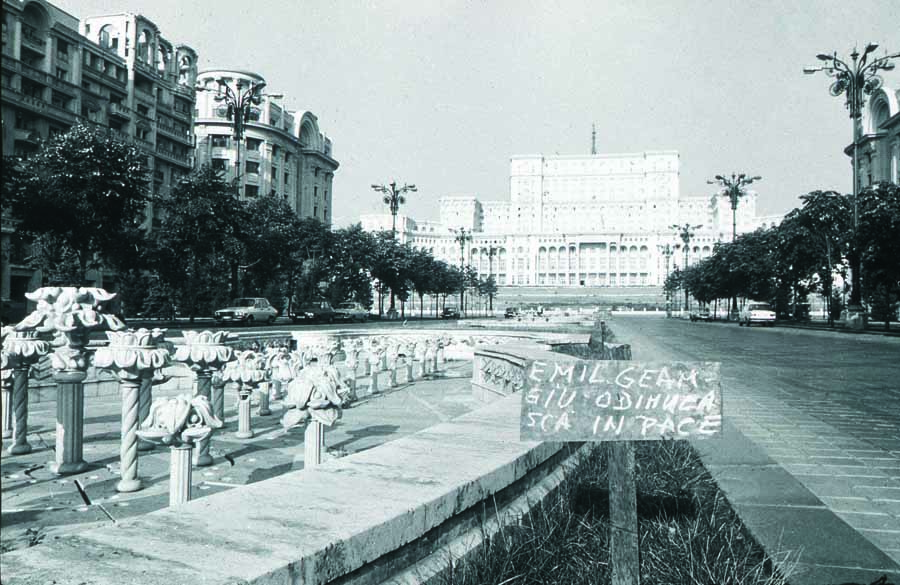
In several of their Draculand installations, subREAL point out that one of the main characteristics of the Dracula myth is the fact that it is a (film) media construct (Murnau, etc.), a fact that the artists reciprocally link once again to the fascination America, and Hollywood especially, has held for generations of Romanian émigrés. Not coincidental in this context is also the fact that subREAL’s title for their installations, Draculaland, is a cognate of the original name for Hollywood, “Hollywoodland.”(The letters making up the word “land” decayed and disappeared from the famous sign that can now be seen above the Los Feliz district in central Los Angeles.) The name Hollywoodland was used in the early 20th century by boosters in Los Angeles to sell Southern California real estate to well-to-do Americans from the Midwest. In their work, subREAL present an ironic Romanian version of this story; in this case it is a South-Eastern European incarnation of Southern California (Transylvania) that is being offered for sale by ruthless “boosters” (the artists themselves), even if the ingredients of the myth are different (garlic and minced meat rather than palm trees and orange groves).(In the installation Draculaland 2, a map of Romania formed of garlic borders directly on a map of the USA formed of corn flour.) This also allows us to take a fresh look at the USA postcards included in the installation Bodies in Motion. If on the one hand, these function as ideological props that sustain the myth of the Golden West, we can now see that they also function as mirrors directed back at Romania whose reflection shows the country in the golden glow of the Communist sun – two ideologies that subREAL here cast as being essentially equivalent with each other.
As these examples show, subREAL recast the East/West opposition as a play with mirrors: by grafting the Western interest in the Eastern Other (Communism) onto precedents that combine East and West (Dracula as a media construct put together from both Western and Eastern sources; America as an “Eastern” myth, etc.) they undercut the East/West binarism, producing an image of the East as seen through the prism of the Western desire for exotic Otherness. The result is an “Easterning” of the West, and a “Westerning” of the East that may account for the often curiously “tainted” or “impure” character of subREAL’s work, its “mixed messages.”
If Dracula is all about real estate, there is another sphere where this is the manifestly case, namely art itself (art is what is in a museum or in a gallery). It may be useful to briefly return to Alimentara at this point: perhaps we can also understand this installation as a self-reflexive critique of the institution of the museum or gallery, and their role in the valorization of art (subREAL return to this theme in their Art History installations). In this reading, Alimentara would refer to the artwork itself literally as “food” for the museum: the art museum would be vampiric in that it produces its own reality effect in the form of a seemingly objectivized, un-biased perspective on art. As with literary Realism, so the art museum, too, relies for the efficacy of its strategy on stripping the objects it exhibits of any signified: once inside the museum, these objects do not signify anything outside of their functioning as art (Duchamp was at the origin of this approach). At the same time, this strategy, which acts as the equivalent of the apparent “objectivity” of literary Realism in Barthes’ account, veils the ideology in which the art museum is enmeshed, from the (class) interests of its sponsors to the politics of its collectors, etc.
In a commentary published in a catalogue that accompanied subREAL’s show at Berlin’s Künstlerhaus Bethanien in 1996, the artists insert a whimsical definition of the word “can” next to a photograph of the Alimentara installation:
Can. A coffin for embalmed food. Like the vampire who cannot live far from his coffin, so post-industrial man, too, can only live in close proximity to his supermarket. Marinated for eternity, the vampire continues to lust for hot drinks, while the ordinary mortal denies himself all immediate access to food and prefers the pre-digested solutions of mortuary-like food chains.(subREAL, Akten/Files, (exhib.cat. Neuer Berliner Kunstverein/Künstlerhaus Bethanien, Berlin], 1996, p. 20.)
If we read this definition by substituting “museum” or “gallery” for “can,” and “art” for “embalmed food” we end up with the vampire as an artist (and the can/museum as his coffin) who continues to “lust for hot drinks” while ordinary people are happy with the pre-digested diet prepared for them by the art institutions. The problem is that in a culture dominated by the irreparable rift between production and consumption, such food (the real, uncontaminated blood of autonomous art production) is exceedingly hard to come by.
subREAL frequently work with the idea of frames and limits, and the way in which such borders create the conditions for art’s functioning as an institution. Nowhere is this more apparent than in the artists’ work with collections. In 1995, they created an archive of color photographs of anonymous spittle on the streets of the Romanian city of Arad (Campaign), suggesting that “to spit into the street seems to be a popular pastime in Romania, just as elsewhere.”(subREAL, Akten/Files, (exhib.cat. Neuer Berliner Kunstverein/Künstlerhaus Bethanien, Berlin], 1996, p. 86.) On the one hand, the artists here once again attest to their interest in non-art, objects or events that, while they can be thought of as art, were not created with a view to becoming art. However, as they proceed to place the individual images in wooden frames as if they were museum exhibits, it becomes clear that non-art cannot stay in this position for long. As soon as a limit or a frame is attached to it – whether material, institutional, or linguistic –, even the formal uncertainty and shapelessnesss of spittle becomes secondary to its functioning as a semiotic “pointer:” once framed and posted along Arad’s main street, the images acquire a function somewhere between an art exhibition and a public education campaign.
In 1993 subREAL temporarily assumed custody over an extensive collection of photographs associated with Arta, a periodical that between 1953 and 1993 was Romania’s only official art magazine (in the words of one critic, “the mouthpiece for the ruling art doctrine of the day.”)(Oliver Marchart, “Der Kunst dienen.” In: Eikon 31, 2000, p. 18. Both Király and Dan worked at the Arta magazine in the late 1980s/early 1990s.) As the artists have pointed out, Arta magazine is a real sourcebook for the history of postwar Romanian art history and its ideological background over four decades. The fact that subREAL, rather than accumulating their own archive, took over an already existing – and no longer active – collection of images that was established by an institution puts them in the same position as other artists who work with an existing collection rather than creating their own. Often, as in the case of Mark Dion, such interventions may subvert or “mess up” existing taxonomies and organizational patterns, which may lead to the foundation of an alternative archive or collection. Dion, in this respect not unlike Los Angeles-based David Bunn who took over the remains of the card catalogue of the L.A. public library when that catalogue was digitized, uses an existing archive to found his own; not by destroying the former but by amplifying it. (In his installation at Documenta 13, Dion added several “modern” volumes to an already existing 18th century collection).
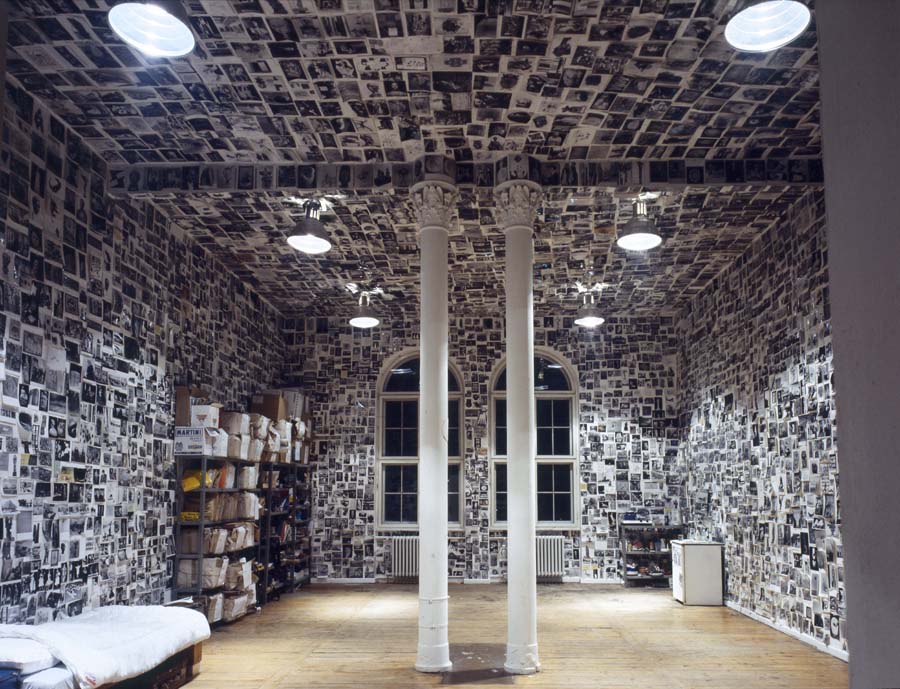 subREAL follow a similar path. In one of their installations (Art History Archive 3. Dataroom Deconstruction, 1995), the artists create what they call a “decaying data space,” with thousands of photographs hung all over the walls of their studio, and progressively falling to the ground. If this installation created the performative context for explaining that the Arta collection was an “archive in ruins,” subREAL also in a sense founded their own archive within the existing collection (much like Dion in this respect) by developing thousands of negatives that were part of the Arta collection but that had never been developed because they were considered irrelevant for the ongoing publication process. Unlike the carefully cropped and edited final images, these negatives showed photographic work in progress, and included camera props, the presence of anonymous helpers, and stage sets in the process of being created. By developing and showing these negatives in a series of installations, subREAL work with the very structure of photography itself, and they extend their analysis to the museum.
subREAL follow a similar path. In one of their installations (Art History Archive 3. Dataroom Deconstruction, 1995), the artists create what they call a “decaying data space,” with thousands of photographs hung all over the walls of their studio, and progressively falling to the ground. If this installation created the performative context for explaining that the Arta collection was an “archive in ruins,” subREAL also in a sense founded their own archive within the existing collection (much like Dion in this respect) by developing thousands of negatives that were part of the Arta collection but that had never been developed because they were considered irrelevant for the ongoing publication process. Unlike the carefully cropped and edited final images, these negatives showed photographic work in progress, and included camera props, the presence of anonymous helpers, and stage sets in the process of being created. By developing and showing these negatives in a series of installations, subREAL work with the very structure of photography itself, and they extend their analysis to the museum.
As a medium, photography is always archival: its focus is reality not as synthetic summary but reality as a collection. A photograph, much like the archive, always contains much more than the photographer has bargained for, and this noise (the image’s archive, as it were) gives it its aura – an aura that originates in photography’s technical parameters, even if its effect does not end there. This aura, the photograph’s archival dimension which is generally not planned or staged, is crucial for subREAL’s work with the Arta collection.
By exhibiting the Arta negatives subREAL valorize not the art works that appeared in the published photographs but the technical operations that allowed for that valorization to occur in the first place, operations that were always shaped by powerful, and evolving, ideological (political and/or art historical) narratives. Among the ideological (technical) operations subREAL reveal in this way is what we might call a photograph’s “theatricalization” at the expense of the image’s archive: the obscuring of photographic detail by the establishment of an artificial wall (a contrastive background) in the form of a handheld piece of cloth or a bed linen behind the object to be captured, as if the latter was a wild animal hunters were trying to apprehend by throwing a blanket over it.
To exhibit such images, and to reveal the counter-archival techniques that allow them to function as mechanisms of signification, is to lay one’s finger on the meaning production of the museum itself. Indeed, modern (art) museums use the very same mechanisms (artificial focus; individual hanging; pervasive order) to organize their collections, techniques designed to allow for art objects to become meaningful within existing ideological (art historical, social, or educational) narratives.(Rosalind Krauss has argued that modern museums create (art historical) meaning by creating a context for comparison based on the way meaning is created in language as understood by structural linguistics (contrast; opposition; etc.). See Rosalind Krauss, “Postmodernisms Museum Without Walls,” in Thinking about Exhibitions, edited by Greenberg, Reesa et al., Routledge, 2005. pp. 241-245.) subREAL immerse themselves in the Arta collection to see if it might be possible to get behind the way in which museums (and art magazines) confer meaning. When as part of their Bethanien project they proceed to live in (or with) their archive for twelve full months, they establish a kind of anti-museum without spacing, organization, other kinds of valorization that is facilitated by such techniques. Aligning their work with similar practices in the West where artists such as Andrea Fraser or Michael Fehr have de-sublimated the archive behind the museum in an effort to lay bare the mechanisms that allow them to function,(See Sven Spieker, The Big Archive. Art From Bureaucracy, The MIT Press, Cambridge, Mass., 2008, pp. 173-191.) subREAL create a musée imaginaire in André Malraux’s sense of the term. For since in their installation no artificial walls keep the viewers gaze in focus (the photographs hang, or lie, in random order all over the walls and the floor), the museum’s mechanisms for the production of meaning (the “wall;” organization; spacing; cropping) become here themselves the focus of the exhibition. The fact that the artists live in their own museum may be viewed as an ironic allusion to pre-19th century art collections where the meaning of art works was not vested in order and organization but rather in their symbolic connection with a noble collector: much like such collectors, subREAL confront “their” collection every time they get out of bed.





